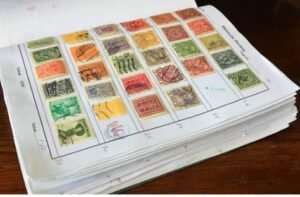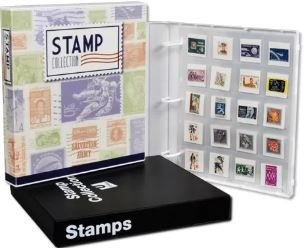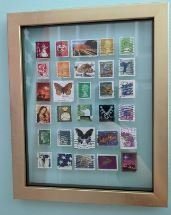For stamp collectors, one of the most rewarding parts of the hobby is building a collection that tells a unique story. But all too often, as a collection grows, the process of organizing it becomes overwhelming. How to organize your stamp collection is a question every collector faces, whether they are beginners or seasoned philatelists. Organizing your collection effectively not only enhances its value but also makes it easier to manage and enjoy.
In this article, we’ll explore how to organize your stamp collection, providing you with essential tips for sorting, categorizing, and preserving your stamps. We’ll also highlight common mistakes to avoid—so you can master the art of sorting your stamps and avoid costly errors that could damage your valuable collection.

Step 1: Assess Your Collection
Before diving into the actual organization process, it’s important to first assess the current state of your stamp collection. Ask yourself these questions:
- How many stamps do you have?
- Are they already sorted in any way (by country, theme, year, etc.)?
- Are they stored properly, or do they need better protection?
How to organize your stamp collection begins with understanding where you are, so you know where to start. If your stamps are in disarray, you may need to spend time unearthing duplicates, damaged stamps, or misplaced items. By taking stock of your collection, you can avoid wasting time organizing stamps that don’t belong in your collection or that might need to be discarded.
Step 2: Decide on Your Sorting Method
One of the most important steps in how to organize your stamp collection is deciding how you want to sort your stamps. There are several common methods for organizing, and choosing the right one depends on your collecting goals and preferences.
By Country or Region
For many collectors, sorting stamps by country is the most straightforward and logical method. If you’re collecting stamps from around the world, this system helps you quickly identify stamps from different countries or territories. For collectors focused on specific regions, such as Europe or Asia, sorting by continent or geographical area can be equally effective.
Mistake to Avoid: Avoid random grouping of stamps without considering a system. How to organize your stamp collection effectively means sticking to a well-defined approach that will save you time in the long run.
By Theme or Topic
If your collection is focused on a particular theme, such as wildlife, space exploration, or historical events, then organizing your stamps by theme is a great way to keep everything cohesive. This method allows you to group stamps by a common subject, making your collection more enjoyable to view.
Mistake to Avoid: Don’t mix unrelated themes or overcrowd categories. For example, putting animal stamps alongside historical event stamps can create confusion and make it harder to enjoy your collection.

By Date or Year of Issue
For more advanced collectors, organizing stamps by date of issue or year provides an extra layer of depth. This method works especially well for collectors interested in specific periods or looking to create a historical timeline of stamp production.
Mistake to Avoid: If you choose this method, be mindful of stamps with multiple releases or reprints from the same year. Misplacing these items can create confusion and prevent you from properly organizing your collection.
Step 3: Choose the Right Storage Solutions
Proper storage is key to maintaining the integrity and value of your stamp collection. How to organize your stamp collection isn’t just about sorting; it’s also about ensuring that your stamps are well-protected and easy to access.
Stamp Albums and Binders
Stamp albums are a popular choice for collectors looking for a simple, organized storage solution. You can buy pre-made albums or customize your own. Be sure to use acid-free pages and mounts to protect your stamps from damage.
Mistake to Avoid: Avoid using plastic pages that are not acid-free, as they can cause your stamps to deteriorate over time. Always opt for high-quality, archival-grade materials.
Stamp Stock Books and Boxes
For collectors with a larger number of stamps or those who prefer a less structured method, stock books or boxes are a flexible solution. These allow you to keep stamps loosely organized while still protecting them. Stock books have transparent pockets that allow you to view both sides of the stamps.
Mistake to Avoid: Don’t overstuff stock books or boxes. This can cause stamps to become bent or damaged. Always leave enough room for your collection to grow and breathe.
Step 4: Label and Index Your Collection
To ensure easy retrieval and future growth, consider labeling or creating an index of your collection. You can use a spreadsheet or database to track your stamps by their catalog number, country, year, and value. This index will help you manage the collection more effectively and avoid purchasing duplicates.
Mistake to Avoid: Don’t skip the labeling process. If you leave your collection unindexed, you may end up wasting time searching for specific stamps or forgetting what you have.

Step 5: Regularly Review and Update Your Collection
How to organize your stamp collection isn’t a one-time task. It’s important to regularly review your collection to ensure it’s up to date. As you acquire new stamps or add to your thematic collection, be sure to re-organize your albums and adjust your labeling system. This will help you stay on top of your collection’s growth and avoid any future disorganization.
Mistake to Avoid: Don’t let your collection grow uncontrollably. Without regular reviews and updates, your organization system can quickly fall apart, leading to a chaotic and frustrating experience.
Conclusion
Mastering how to organize your stamp collection is an essential skill for every collector. By carefully assessing your collection, choosing the right sorting method, investing in proper storage, and labeling, and regularly updating your collection, you can ensure that your stamp collection remains well-organized and easy to manage. Most importantly, by avoiding common mistakes like improper storage, chaotic grouping, and neglecting regular updates, you’ll prevent costly errors that could damage your valuable stamps.
How to organize your stamp collection doesn’t have to be a daunting task. With the right approach and tools, you can turn a chaotic collection into a carefully curated masterpiece. Whether you’re a novice or a seasoned collector, these tips will help you stay organized, focused, and on track for future success in the world of philately.
Online resources for stamp collectors offer an abundance of tools to enhance your collecting experience. By uncovering valuable resources and being aware of common mistakes, you can make the most of your philatelic journey.




